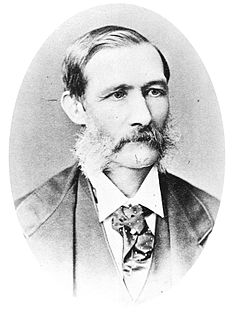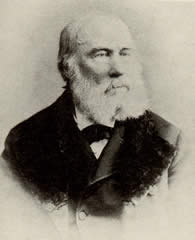Related Research Articles

Hugh Falconer MD FRS was a Scottish geologist, botanist, palaeontologist, and paleoanthropologist. He studied the flora, fauna, and geology of India, Assam, and Burma, and was the first to suggest the modern evolutionary theory of punctuated equilibrium. He was the first to discover the Siwalik fossil beds, and may also have been the first person to discover a fossil ape.

Nathaniel Wolff Wallich FRS FRSE was a surgeon and botanist of Danish origin who worked in India, initially in the Danish settlement near Calcutta and later for the Danish East India Company and the British East India Company. He was involved in the early development of the Calcutta Botanical Garden, describing many new plant species and developing a large herbarium collection which was distributed to collections in Europe. Several of the plants that he collected were named after him.

Sir Dietrich Brandis was a German-British botanist and forestry academic and administrator, who worked with the British Imperial Forestry Service in colonial India for nearly 30 years. He joined the British civil service in Burma in 1856, shortly afterwards became head of the British forestry administration in all of Burma, and served as Inspector General of Forests in India from 1864 to 1883. He returned to Europe in 1883, dividing his time between Bonn and Greater London. In retirement he dedicated himself to scholarly work, resulting in his monumental book Indian Trees (1906). Brandis is considered the father of tropical forestry and has also been described as the father of scientific forestry. In addition to his work in India, he also had a significant influence on forest management in the United States.

Walter Hood Fitch was a botanical illustrator, born in Glasgow, Scotland, who executed some 10,000 drawings for various publications. His work in colour lithograph, including 2700 illustrations for Curtis's Botanical Magazine, produced up to 200 plates per year.

Sir George King was a British botanist who was appointed superintendent of the Royal Botanic Garden, Calcutta in 1871, and became the first Director of the Botanical Survey of India from 1890. He was recognised for his work in the cultivation of cinchona and for setting up a system for the inexpensive distribution of quinine throughout India through the postal system.

John Forbes Royle, British botanist and teacher of materia medica, was born in Kanpur in 1798. He was in charge of the botanical garden at Saharanpur and played a role in the development of economic botany in India.

Robert Wight MD FRS FLS was a Scottish surgeon in the East India Company, whose professional career was spent entirely in southern India, where his greatest achievements were in botany – as an economic botanist and leading taxonomist in south India. He contributed to the introduction of American cotton. As a taxonomist he described 110 new genera and 1267 new species of flowering plants. He employed Indian botanical artists to illustrate a large number of plants collected by himself and Indian collectors he trained. Some of these illustrations were published William Hooker in Britain, but from 1838 published a series of illustrated works in Madras including the uncoloured, six-volume Icones Plantarum Indiae Orientalis (1838–53) and two hand-coloured, two-volume works, the Illustrations of Indian Botany (1838–50) and Spicilegium Neilgherrense (1845–51). By the time he retired from India in 1853 he had published 2464 illustrations of Indian plants.

William Griffith was a British doctor, naturalist, and botanist. Griffith's botanical publications are from India and Burma. After a brief stay in Madras, he was assigned as a Civil Surgeon to Tenasserim, Burma, where he studied local plants and made collecting trips to the Barak River valley in Assam. He explored various parts of Burma, traveling the rivers, including the Irrawadi as far as Rangoon. He visited the highlands of Sikkim, and the region of the Himalayas around Shimla. Subsequently, Griffith was appointed as Civil Surgeon in Malacca, where he died of a parasitic liver disease.

Colonel Robert Kyd was a British army officer stationed in India. He founded the botanical garden at Calcutta in 1787.
Alphonsea maingayi is a species of plant in the Annonaceae family. It is found in Malaysia and possibly Singapore.

Hugh Francis Clarke Cleghorn of Stravithie, FRSE FLS LLD was a Madras-born Scottish physician who worked in India and pioneered as a botanist and in forest conservancy. Cleghorn, sometimes known as the father of scientific forestry in India, was instrumental in the creation of the forest department in the Presidency of Madras. The plant genus Cleghornia was named after him by the botanist Robert Wight. Cleghorn returned to Scotland in 1869 and developed forestry education in Scotland and established a lecturership at the University of Edinburgh.

James Edward Tierney Aitchison MD LLD CIE was a Scottish surgeon and botanist. He worked as British Commissioner to Ladakh, India in 1872 and collected numerous specimens from the region and published catalogues of plants including those of economic interest. The plant genus Aitchisonia was named after him by Helmsley but the name is no longer in use.
The Botanical Society of Scotland (BSS) is the national learned society for botanists of Scotland. The Society's aims are to advance knowledge and appreciation of flowering and cryptogamic plants, algae and fungi. The Society's activities include lectures, symposia, field excursions, field projects and an annual Scottish Botanist's Conference, held jointly with the Botanical Society of Britain and Ireland for exchange of information between botanists working in different areas. Its publications include a twice-yearly newsletter, BSS News, and a scientific journal, Plant Ecology & Diversity. The society is closely linked to the Royal Botanic Garden Edinburgh and the Scottish universities.
George Gardner was a Scottish biologist mainly interested in botany.
Limnocharis is a genus of plants in the family Alismataceae, native to Mexico, Central America, the West Indies and South America) but naturalized in China, India, and Southeast Asia as well. Two species are recognized as of May 2014:

Henarathgoda Botanical Garden is one of the six botanical gardens in Sri Lanka. The botanical garden is situated on the Gampaha-Minuwangoda main road, approximately 450 m (1,480 ft) away from Gampaha railway station. It is about 29 km (18 mi) from Sri Lanka's commercial capital of Colombo.
Dr James W. Byng is a British botanist and is currently Director of Plant Gateway, a Visiting Research Fellow at Naturalis Biodiversity Center and an Honorary Research Fellow at the University of Aberdeen. He was trained at the University of Aberdeen, Royal Botanic Gardens Edinburgh and Royal Botanic Gardens, Kew. Dr Byng is a consultant to Plant Gateway Ltd.
Marmaduke Alexander Lawson was a British botanist.

Peristylus maingayi, commonly known as the white ogre orchid, is a species of orchid that is native to southern Indochina, New Guinea and north Queensland. It has two or three broad leaves near its base and up to fifteen small white flowers that are tube-shaped near the base and have a three-lobed labellum.
Mitrephora maingayi is a species of plant in the family Annonaceae. It is native to Bangladesh, Borneo, Cambodia, Laos, Peninsular Malaysia, Myanmar, Sumatra, and Vietnam. Joseph Hooker and Thomas Thomson, the British botanists who first formally described the species, named it in honor of Alexander Carroll Maingay, the British botanist who collected the specimen they examined.
References
- 1 2 3 Craig, William (1870–71). "I.On the Formation of a Museum of Vegetable Materia Medica". Transactions of the Botanical Society of Edinburgh. 10 (1–4): 376–377. doi:10.1080/03746607009468720. ISSN 0374-6607.
- ↑ C., Maingay, Alexander (1858). "Monograph on the British parmeliaceae". hdl:1842/24118.Cite journal requires
|journal=(help) - ↑ "MaingayAC". www.nationaalherbarium.nl. Retrieved 2018-08-02.
- 1 2 "Maingay, Alexander Carroll (1836-1869)".Cite journal requires
|journal=(help) - ↑ "Artocarpus maingayi King | Plants of the World Online | Kew Science". Plants of the World Online. Retrieved 2018-08-02.
- ↑ "HerbWeb - Details Page". specimens.kew.org. Retrieved 2018-08-02.
- ↑ IPNI. Maingay.